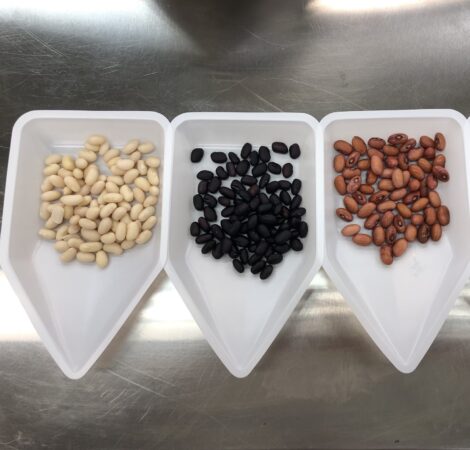
Canada’s pulse revolution: Canned bean liquids as egg alternatives
By Jessica Chang and Dr. Iris. J. Joye
Research & Development Ingredients & Additives Plant-based foods Pulse Canada Ontario-grown beans. Images © Cereal Lab (University of Guelph)
Ontario-grown beans. Images © Cereal Lab (University of Guelph) The daily routine of eating can quickly become a challenge when faced with the need to avoid certain foods. With such limitations, cooking requires increased consideration as well as caution when ordering from restaurant menus. Sadly, limited strategies for replacing these foods can restrict consumable options for affected consumers and result in decreased quality of life from nutritionally sub-optimal diets.6,7 Therefore, expanding the arsenal of accessible alternatives that both consumers and the food service industry can use is needed.
The call for egg alternatives
To keep pace with the dynamic dietary requirements of Canada’s growing population, which is projected to reach 42.19 million in 2028, research into functional alternatives for commonly used ingredients has risen and spans a wide array of categories.4 However, one of the most notable of these ingredients would be the widely used chicken’s egg for several reasons.
Eggs rank as one of the world’s top nine allergens for reaction severity and affects six to 10 per cent of children on a global scale.2,3 In addition to allergies, consumers avoid eggs in the interest of healthier eating, animal ethics and support of more environmentally sustainable agriculture, thus pushing more of the population toward plant-based foods.2 As such, it is no surprise that a survey asking 1600 adult Canadians revealed that, across the different regions in Canada, an impressive 51-72 per cent answered favourably to being open to consuming more plant-based products.1

Top and below: Microscopic view of foams.
A possible lead
However, where does one begin to find suitable egg alternatives with similar functional properties as eggs that can also address all the previously mentioned concerns? A possible solution may lie in Ontario’s thriving pulse market. Based on the already well-published foaming properties of a pioneer for plant-based egg substitutes, known as “aquafaba” (the canned liquids of chickpeas), the otherwise discarded canned liquids of beans are currently being researched as alternative foaming agents to eggs. Food applications where eggs could be replaced by these canned bean liquids include meringues, creams, and even foam-dependent baked goods such as cakes in which foam is needed for a risen, airy structure.
Why spill the beans?
With Ontario as one of Canada’s leading bean production powerhouses and 76 per cent of pulse products sold being canned, the leftover liquids of canned whole beans have the potential to be highly accessible, allergen-free, healthy and plant-based egg alternatives that also take advantage of a locally grown asset.5 True to the definition of pulses by Pulse Canada (2023), beans “…are very high in protein and fibre, and low in fat. Pulses are nitrogen-fixing crops that improve the environmental sustainability of cropping systems…” thus satisfying the above requirements.9
While chickpeas remain a popular go-to for vegan recipes, beans are one of the most preferred sources of protein in vegetarian, vegan and ethnic dishes, according to survey responses from fully vegetarian and vegan adult Canadians.9,10 As a result, egg-avoiding consumers may often find themselves cooking with canned beans or purchasing foods with beans from small businesses or restaurants, thus making the canned liquids themselves a readily available resource. As such, vegan establishments and home cooks alike can replace eggs by using an alternative that better caters to their daily cooking or production as opposed to just when chickpeas are used.
Potential impact
While research into these canned liquids is still underway, it is a worthy pursuit and even reaches outside the Canadian borders. The call for egg alternatives is not limited to Canada but has also made waves in the United States where the projected market value for the egg substitutes in 2032 reaches US$419.2 million.8 With this “waste stream-turned-resource,” food services can create other egg-free products while simultaneously preparing dishes that utilize pulses other than chickpeas. Investigation into these liquids can also spark a broader incentive to investigate the valorization of food factory production level wastewater for other recyclable resources. The potential of this research will not only add value to the entire canned bean product itself, but also take advantage of one of Canada’s production strengths as the accommodation of consumer dietary restrictions remains a well-pronounced objective in the realm of food science.
References
1 Angus Reid Institute. 2019. Consumers’ view on eating more plant based foods and products in Canada as of March 2019, by region. Statista Canada.
2 Boukid F, Gagaoua M. 2022. Vegan Egg: A Future-Proof Food Ingredient? Foods. 11(2):161. doi:10.3390/foods11020161.
3 Corica D, Aversa T, Caminiti L, Lombardo F, Wasniewska M, Pajno GB. 2020. Nutrition and Avoidance Diets in Children With Food Allergy. Front Pediatr. 8:518. doi:10.3389/fped.2020.00518.
4 IMF. 2023. Total Population of Canada from 2018 to 2028 (in millions). Statista Canada.
5 Ipsos Reid. 2010. Factors Influencing Pulse Consumption in Canada. Calgary, Alberta: Government of Alberta.
6 Miranda J, Anton X, Redondo-Valbuena C, Roca-Saavedra P, Rodriguez J, Lamas A, Franco C, Cepeda A. 2015. Egg and Egg-Derived Foods: Effects on Human Health and Use as Functional Foods. Nutrients. 7(1):706–729. doi:10.3390/nu7010706.
7 Mofidi, Shideh. Nutritional Management of Pediatric Food Hypersensitivity. Pediatrics. 111(6):1645–1653.
8 [PMR] Persistence Market Research. 2023. Size of the egg substitute market in the United States from 2021 to 2032 (in million U.S dollars). Statista Canada.
9 Pulse Canada. 2023. What is a pulse?. Pulse Canada. Available from: https://pulsecanada.com/pulse/what-is-a-pulse
10 Technomic. 2016. What types of plant-based proteins are you most likely to eat?. Statista Canada.
Dr. Iris Joye, PhD, completed her bachelor’s and master’s degrees as well as a PhD in bioscience engineering from the University of Leuven (KU Leuven, Belgium). She joined the Department of Food Science at the University of Guelph, Ont., as cereal science faculty in 2016.
Jessica Chang completed her bachelor’s degree in food science from the University of Guelph. She continued on to do her master’s in food science, under the guidance of Dr. Joye, centred around the functionality of bean aquafabas in 2022.
Print this page
